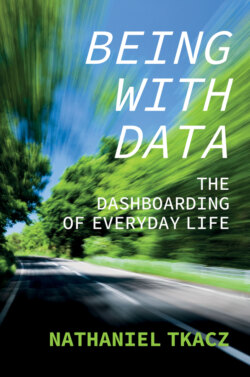Being with Data

Реклама. ООО «ЛитРес», ИНН: 7719571260.
Оглавление
Nathaniel Tkacz. Being with Data
CONTENTS
List of Illustrations
Guide
Pages
Dedication
Being with Data. The Dashboarding of Everyday Life
Acknowledgements
Introduction. Being with Data
Dashboard
Format
Culture
Overview
Notes
1 Archaeology of Dashboards. Format Archaeology
Horse and Carriage: Separation, Motion, Perception
Motor Car: Expertise, Instrumentation, Mythology
Driving: Driverly Perception, Automaticity
Company Reports: Driving Organizations, Timely Data
Management Decision: Active Display, Decision Ontology
Business Intelligence: Generalization
Recap
Notes
2 Formatting Cognition
Cognitive Matters
Dashboarding Hospitals
Cognitive Associations
Calculate and Visualize
Seeing through Hospital Dashboards
Dr Foster Mortality Measures. Hospital Standardised Mortality Ratio (HSMR)
Summary Hospital-Level Mortality Indicator (SHMI)
Deaths after surgery
Deaths in low-risk conditions
Dashboarding Cognition, Formatting Thought
Notes
3 Formatting Data
Data, Epistemology, Truth-Value
Dashboarding Disasters
Making Decisions, Issuing Reports
Uncertainty, Time-Value, Decision-Value
Situations and Situationness
Notes
Coda: Format Politics
Notes
Bibliography
Index
A
B
C
D
E
F
G
H
I
J
K
L
M
N
O
P
Q
R
S
T
U
V
W
Y
POLITY END USER LICENSE AGREEMENT
Отрывок из книги
For Lena
A second set of conversations began when João Porto de Albuquerque became my colleague in the Centre for Interdisciplinary Methodologies (CIM) at the University of Warwick. I have benefited greatly from his kindness and friendship and from his opening new worlds for me. The parts of the book set in Brazil would not be possible without him. Funding from the Belmont Forum, ESRC (ES/S006982/1) and Fundação de Amparo à Pesquisa do Estado de São Paulo (FAPESP) for the project ‘Waterproofing Data: Engaging Stakeholders in Sustainable Flood Risk Governance for Urban Resilience’ enabled us to visit Brazil regularly. Flávio Horita provided early research assistance in the situation room in Cemaden. Following Flávio, Mário Henrique da Mata Martins joined ‘Waterproofing Data’ as a postdoc and became my main collaborator. While the intellectual framing of chapter 3 on ‘Formatting Data’ is my own, it draws on empirical work we did together and often with Mário taking the lead. My gratitude also goes to Maria Alexandra Cunha, based at the Getulio Vargas Foundation in São Paulo, and Vangelis Pitidis at Warwick, for offering a lot of general support with ‘Waterproofing Data’. During my visits to the situation room in Cemaden I made several new friends, including Liana Anderson, Rachel Trajber, Victor Marchezini, Conrado Rudorff and Giovanni Dolif Neto. Thanks for the lunches and dinners, the desk space and making me feel less of an outsider! Research in the situation room would not have been possible without the support of the many specialists who work in the room or support its operation.
.....
even the most theoretical economic science is constantly performing this formatting operation, for its work is much more practical, down to earth, and effective than it would admit. Indeed, economic science extracts from the mobilization of people and things the necessary elements to make the exchanges calculable – and it is precisely this set of operations that we have in mind when we use the notion of formatting.29
And they use it as a way to get at the relation between capitalism and markets: ‘capitalism refers to the formatting of markets’.30 Overall, we get a sense that formatting refers to the ongoing performativity of things. It is the ‘how’ of performativity. It refers to the method of framing some thing or activity in a specific way such that it is amenable to a pre-existing epistemic order (i.e., economic science). And it is used to define how one thing relates to, or acts upon, another.
.....